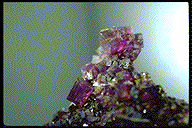 THE MINERAL FIEDLERITE
THE MINERAL FIEDLERITE
- Chemistry: Pb3Cl4F(OH)2, Lead Chloride Fluoride Hydroxide.
- Class: Halides
- Uses: Only as mineral specimens.
- Specimens
Fiedlerite forms tiny, platy, colorless crystals and is an extremely rare mineral.
It is known from one location, its type locality of
Lavrio (formerly Lavrion and Laurium), Greece.
An ancient lead mining area.
Fiedlerite is named for a nineteenth century director of the mines, K. G. Feidler.
Other rare minerals from this locality include
paralaurionite,
zincaluminite,
nealite,
laurionite,
penfieldite,
agardite,
serpierite,
thorikosite,
ktenasite,
glaucocerinite,
beudantite,
georgiadesite and
phosgenite
to name just a few.
There are easily over three hundred and seventy minerals known from this locality.
This locality has been mined for centuries starting with the Greeks and then the Romans for the lead content of its ores.
The left over rocks, that were judged too poor in the metals to be processed by the ancient miners, were dumped into the sea.
Such mining dumps are called slag dumps.
Today these dumps are being reprocessed for their valuable metals by modern ore processing techniques that are capable of extracting the metals from these ores.
Analysis of these rocks have yielded some amazing new minerals.
Some of these minerals were not there when the rocks were first mined centuries before.
But they are there now!
The sea water altered the low grade lead ores and produced a most unusual assortment of rare minerals of which fiedlerite is one of them.
Many people do not consider these minerals to be true minerals because their creation was indirectly aided by the actions of humans and therefore not exactly natural.
Minerals must have a natural origin in order to be minerals.
However, these minerals were only indirectly affected and the study of their origins is best left to mineralogists.
Fiedlerite and others minerals with similar chemistries belong to a division in the Halide Class called the Oxyhalides and Hydroxyhalides.
These minerals have either oxygen or hydroxide groups in their chemistries.
The oxygen atom in their chemistries might require their classification in the
Oxides Class
of minerals except that their structures are more tied to the halide elements and the oxygens and hydroxides are kind of superfluous to the overall structure.
PHYSICAL CHARACTERISTICS:
- Color is colorless and white.
- Luster is adamantine.
- Transparency: Crystals are transparent to translucent.
- Crystal System is monoclinic; 2/m.
- Crystal Habits include tiny tabular to platy crystals.
- Cleavage is good, but not discernible.
- Fracture is conchoidal.
- Hardness is 3.5.
- Specific Gravity is 5.88 (very heavy for translucent minerals)
- Streak is white.
- Associated Minerals include
paralaurionite,
laurionite and
phosgenite
- Notable Occurrence is limited to its type locality of
Lavrio (formerly Lavrion and Laurium), Greece.
- Best Field Indicators are crystal habit, density and locality.







